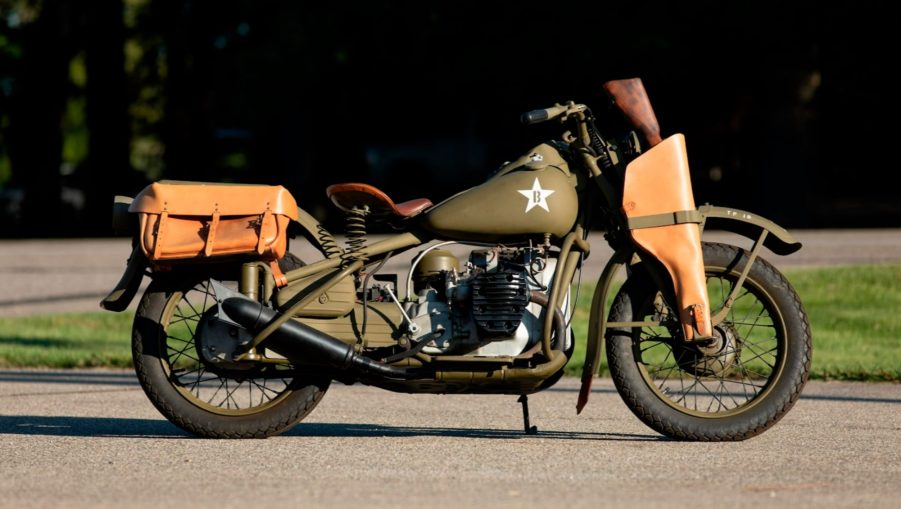
This Obscure WW2 Harley-Davidson Tried Beating BMW With Its Own Boxer
If you believe that Harley-Davidson only knows how to make big V-twin cruisers think again. But I’m not just talking about The Motor Company’s latest electric motorcycle and e-bike ventures. Its history is more varied than many realize, and it includes everything from café racers to genuine sportbikes. And long before the BMW R 18 faced Harleys on the street, the Harley-Davidson XA aimed to fight BMWs in WW2.
The WW2 Harley-Davidson XA floated like a Harley but stung like a BMW R71 boxer

Motorcycles played a major role in WW2 on both sides of the war. Being lighter and smaller than cars, they were easy to move and could often travel further afield. As a result, they were excellent choices for scouts and couriers. And with a sidecar, bikes could carry wounded soldiers, supplies, and munitions. Plus, motorcycles are easier to wrench on than cars—and you don’t want to be stuck with a flooded carburetor in a warzone.
However, when it came to the kinds of motorcycles that armies fielded in WW2, the Nazis had a significant advantage: the BMW R71 and R75M. True, their air-cooled boxer engines weren’t powerful, but it was torquey, and that matters more in muddy fields. Also, their low compression ratios meant it could run on low-quality fuel without issue. And because boxer-twin cylinders stuck out so far, overheating wasn’t an issue. Plus, both bikes were very simple to work on, especially because of their low-maintenance shaft drives.
To be fair, the Harley-Davidson WLA, the original US Army bike in WW2, had some of these qualities. Namely, a durable, low-compression engine with plenty of low-end torque and an overall sturdy design. However, the WLA had a higher-maintenance chain drive, not a lot of ground clearance, and its V-twin didn’t have the best cooling setup. That last part was particularly problematic in places like North Africa’s scalding sands.
Recognizing these limitations, the US Army asked Harley-Davidson and Indian to design a motorcycle that could rival the BMW boxers. And because time was short, they decided to just copy the Germans’ homework. Literally, Harley got a civilian R71 and “’just converted everything from millimeter to inch and built it,’” Motorcyclist reports. And so, the 1942 Harley-Davidson XA (‘Experimental Army’) was born.
It was innovative and interesting, but the Harley-Davidson XA never saw a battlefield

Admittedly, the Harley-Davidson XA wasn’t the only WW2 BMW boxer clone. Ural’s bike designs stem from the same R71/R75 source. And the Condor A580 military motorcycle is basically a modified BMW. Plus, there was Indian’s attempt, the 841.
However, the Harley-Davison XA was the brand’s first—and so far, only—boxer-twin motorcycle. And the novel (for Harley) engine layout made a significant difference. For one, the bike’s 738cc boxer ran about 100°F cooler than the WLA’s V-twin, Mecum says. Secondly, it let Harley give the motorcycle 7” of ground clearance. Plus, its shaft drive isn’t affected by sand like a chain would be.
However, the XA introduced more Harley-Davidson ‘firsts’ than just the boxer engine. It’s the first Harley-Davidson motorcycle with a floor-mounted shifter, rather than a hand shifter. The XA is also the first Harley with a four-speed transmission, welded frame, twin carburetors, and rear suspension. Plus, the 1943 XA Type II was the first Harley with telescopic forks; production Harleys didn’t have them until 1949.

While 23 horsepower doesn’t sound like much today, it was enough to get the Harley-Davidson XA to 65 mph. It could also take a solid hit thanks to its skid plate and crash bars. And its rear rack could hold up to 40 pounds of cargo. Plus, its left-hand throttle meant soldiers could shoot and ride at the same time.
But despite its benefits, the Harley-Davidson XA never saw full production. The then-new Jeep could haul more equipment and people at once deep into the field. And the XA was noticeably more expensive to produce than the WLA and Indian Scout. So, after going through initial testing, the XA was left behind.
The XA is beating the R71 when it comes to classic motorcycle prices
Because of its limited deployment and production, the Harley-Davidson XA is more obscure than many of its WW2 brethren. Estimates vary, but they generally agree that Harley only made 1,106 XAs, Mecum says. In contrast, it made something like 80,000 V-twin motorcycles for the war effort.
As a result, a well-kept XA is more valuable than an R71. A good-to-excellent-condition XA typically goes for $30,000-$40,000 these days, Hagerty reports. Mecum recently sold one at its 2022 Las Vegas auction for $45,100. Meanwhile, an R71 in the same condition usually costs $17.5K-$24K, Hagerty says. And while a military R75 is often a $37,000-$50,000 motorcycle, it’s gone down in value recently, Hagerty notes.
It seems the XA did beat BMW with its own boxer after all.
Follow more updates from MotorBiscuit on our Facebook page.


